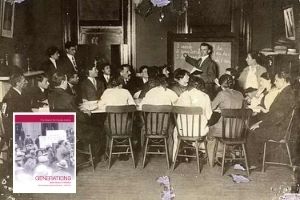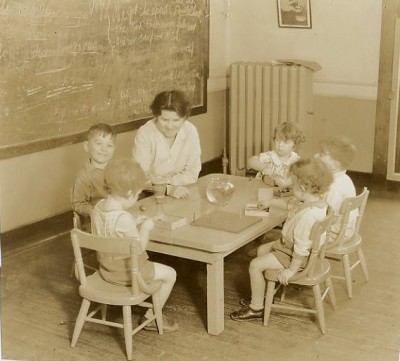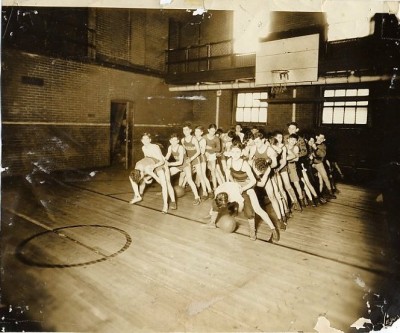A “Children’s Playground” and “Centre for Adults” Part IV

Article by Jennifer Vess. Originally published in Generations 2009-2010: 50th Anniversary Double Issue: The Search for Social Justice.
Part IV: The Infant Is Safe
Missed parts 1 – 3? Start from the Beginning.
From the moment of the institution’s founding, the JEA staff focused much of its energy on the children of East Baltimore. Children could learn quickly and were often more willing to learn than their parents. As one historian put it, “not only were they captivating and genuinely responsive, but they were the best candidates for the primary settlement purpose of shaping character through personal influence. The children also offered the most important entrée into the life of the neighborhood.”[1] They were also a source of great concern because they were subject to the influence of people and activities that the JEA board and staff considered disreputable. The JEA’s leaders prided themselves on providing a positive environment, which kept kids off the streets, and more particularly out of jail.
Attention to the needs of children began in infancy at the JEA with a nursery and kindergarten. Before JEA leaders had even settled on an official name, they established a committee for the Kindergarten and the Day Nursery. The nursery cared for children under school age. While the middle-class ideal of the early 1900s painted a picture of men at work and women in the home, both fathers and mothers in East Baltimore often had to work outside of the house to provide for the family. As Lewis Putzel, JEA president, explained in 1913, “The burdened mother will leave here her infant for the day, and know the infant is safe.” For the children, the nursery offered an environment for early learning, including art and Jewish culture among all of the other lessons.[2] The JEA nursery, one of the first in Baltimore, functioned from 1909 until 1952, when the JEA closed.

Kindergartens were an important innovation championed by reformers and progressive educators in the early twentieth century, and the JEA opened one almost immediately. The goal “throughout the kindergarten term was not to instill knowledge in the child as much as to lead him to observe and think,” the staff explained in 1917, when the school year opened with an impressive 120 students. That year the teachers introduced the idea of adding Montessori materials. Despite the success of the JEA kindergarten, the ultimate goal was to transfer it to the public school system. Progressive-era reformers strove to offer essential services to the working poor, but they believed that the government should eventually take over the running of these essential activities. In 1921 the public school system did take over the administration of the kindergarten though it continued to be operated at the JEA.[3]
As children became older, the JEA endeavored to draw them away from the temptation of less reputable entertainments, especially game rooms and dance halls. The settlement workers took two approaches – providing similar but more wholesome activities at the JEA, and shutting down or cleaning up the neighborhood’s more objectionable enterprises. Though the JEA’s list of committees did not initially include entertainment, by 1911 they had added one. As an alternative to rowdy dance halls, the JEA held dances for neighborhood teenagers and young adults starting in 1909. The JEA offered its own game room where children could play chess and checkers or carom pool, a version of billiards played on a smaller table.
As with settlement houses across the country, the JEA worked to extend its influence throughout the neighborhood, launching campaigns against area bars, game rooms, and dance halls. In 1913 the board formally thanked the liquor license commissioners for closing the Hotel Theodore. Seven years later the JEA aimed its sights at the dance halls. In December 1920 the JEA director proposed that the Association of Neighborhood Workers set out to “devise means of influencing Orchestra Leaders thruout [sic] the City to modify the exceedingly jazzy mode of playing. The Association attributed disorder, in many cases, to the music.” The JEA also campaigned against “disorderly houses” – that is, brothels. JEA director Max Carton organized a community meeting at the Eden Street Synagogue in April 1912 to create a formal protest to present to the Supreme Bench and State’s Attorney of Baltimore in order to have local brothels shut down.[4] The board and staff of the JEA pushed the boundaries of their work beyond the brick walls of their building, trying to create a better environment on a large scale.

The JEA clubs were perhaps the most popular and frequently remembered of all the activities for children. Under the supervision of an adult advisor the children set up the clubs themselves and ran their meetings according to standard business guidelines, electing officers and keeping minutes. The names of the clubs tell us little about the character of each group though they must have meant something to the boys and girls, names like the Aetna Club, Olivet Club, Champion Club, Harvard Club, Sunshine Club, Harmony Club, Puritan Club, and more. Each club, usually separated by gender and age, organized outings to the country, formed sports teams, and sought to improve its members through literary reports and debates. Long after children became adults, in fact long after the JEA ceased to exist, club members continued to meet in alumni gatherings.
Sports featured prominently in the lives of JEA children. They participated in wrestling, track and field, baseball, and perhaps most important, basketball. JEA teams competed against one another and also against teams citywide. The Alliance Citizen and the Baltimore Jewish Times often followed the JEA’s sports activities, reporting on wins and losses and posting schedules for the community. Games were well-attended, with spectators sometimes running into the hundreds. Reminiscences suggest that everyone had the opportunity to participate, whether they were accomplished athletes or not. The JEA boys and girls prided themselves on their successes (which were many) on the field or court, but they participated in athletics because they loved them.[5]
Continue to Part V: End of an Era
Notes:
[1] Mina Carson, Settlement Folk, 62.
[2] JEA meeting minutes, November 7, 1909, and November 16, 1921, MS 170, Folders 212 and 213.
[3] JEA meeting minutes, June 5, 1917 and April 6, 1921, MS 170, Folder 213, JMM. On the Progressive goal of expanding government services, see Davis, Spearheads for Reform.
[4] JEA meeting minutes, April 14, 1913, MS 170, Folder 212; resident director report, December 7, 1920, JEA meeting minutes, MS 170, Folder 213; “East Enders Protest,” Baltimore Sun, April 8, 1912, p. 9.
[5] Jobi Zink, “Amateur Jewish Athletes, Then and Now,” Generations (2004): 84-87.
